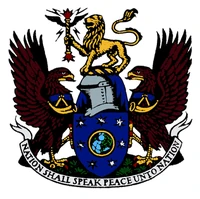This page only shows primary logo variants. For other related logos and images, see:
|
| 1997–present | ||||
| 1958–1963 | 1963–1971 | 1971–1992 | 1988–1998 | 1997–present |
| 1927–1988 | 1988–present |
The British Broadcasting Corporation (BBC) founded in 1922 is a British public service broadcaster. Its headquarters are at Broadcasting House in Westminster, London and it is the world's oldest national broadcasting organisation.
Main logo
1958–1963
The first incarnation of the BBC blocks logo was created in 1958. This logo consisted of square boxes with 'BBC' in italics inside them. In 1953, Abram Games was commissioned to design an on-air image. The font used would be 'Univers', which was created in 1957.
1963–1971
On 30 September 1963, the boxes were also made slanted like the letters. This type of logo would go on captions at the end of productions as well as on cameras and other equipment. 1964 saw the creation of both of its channels BBC1 and BBC2, with the distinctive horizontal stripes across the screen.
1971–1992
In 1971, a new softer logo was made by rounding off the boxes, making the spaces between the boxes larger. A corporate identity was getting more and more essential to ensuring that the audience knew it was authentic and that the quality programmes they were watching could be attributed to the BBC.
This logo continued to be used alongside the 1988 logo until 1992.
1988–1998
In August 1988, the BBC launched yet another new logo, which was designed by Michael Peters.
The logo was modified by sharpening up the parallelogram edges again and set to an angle of 17 degrees without reducing the size of the spaces between the boxes. The text was also sharpened up to make it match the clarity of the logo itself - the typeface used was 'Helvetica Neue'. Also, under-logo lines were added for the first time. These lines were coloured blue, red and green to reflect the flags of Scotland, Wales, and Northern Ireland, as well as the three phosphors of colour television.
This logo continued to be used as an in-credit logo and with the BBC Radio Clwyd logo until the radio station eventually shut down in August 1998.
1997–present
On 4 October 1997, the BBC launched a new identity, designed by Martin Lambie-Nairn.
The under-logo lines were removed from the logo, the boxes and letters were also straightened up, making the boxes look similar to the 1958 logo. The typeface used is 'Gill Sans', made by Eric Gill in 1926. BBC1 and BBC2 were also renamed BBC One and BBC Two. By the end of 2002, most services were using a different design with the logo and name on top of each other in a box. This logo is the longest-lived in the history of the BBC, having been used for more than two decades.
Since 2017, BBC is slowly replacing 'Gill Sans' with 'BBC Reith Sans and Serif', with the first being BBC Sport, followed by BBC Alba, then BBC Two's rebranding, then BBC Scotland's channel launch and most recently, BBC News, as well as its news channel and BBC World News. BBC Four continues to use Gill Sans for its channel.
BBC Coat of Arms
1927–1988
Shortly after receiving its first Royal Charter in 1927, the BBC was granted its own armorials by the College of Arms.
The British lion forms the 'crest' of the arms, and the thunderbolt it holds is a heraldic way of representing broadcasting. The eagles form the 'supporters', and represent speed, while the bugles they wear round their necks symbolise public proclamation.
On the shield is the globe surrounded by seven stars, which represent the other seven planets in the Solar System and hence reflect the scope and breadth of the Corporation. Finally, the motto, "Nation shall speak peace unto nation", is based on verses from the Old Testament (Micah 4:3 and Isaiah 2:4).
1988–present
An updated Coat of Arms was introduced with the underlined BBC logo (see above) in 1988, retaining all the properties of the original arms but making them appear more defined.
External links
| Eurovision/Euroradio ARD |
ARMR |
ARMTV |
BBC |
BHRT |
BNR |
BNT |
ČRo |
ČT |
CyBC / RIK |
DR |
ENRS |
EPTV |
ERR (ETV) |
ERSL |
ERT (ERA) |
ERTU |
GPB |
FMM (F24 | MCD | RFI) |
France.tv |
HRT (HR) |
İCTI (İR | İTV) |
JRTV |
Kan (IPBC) |
LNC |
LRT |
LSM (LR | LTV) |
MMD |
MRT |
MTVA (Duna) |
NPO |
NRK |
NSTU |
ORF |
PBS Ltd. |
PR |
RAI |
Radio France |
ROR |
RT |
RTBF |
RTCG |
RTÉ |
RTL |
RTP |
RTS |
RTSH |
RTVA |
RTVE (RNE | TVE) |
RTVS |
RTVSLO |
RÚV |
SMRTV |
SNRT |
SRG SSR |
SRT (SR | SVT | UR) |
TDA |
TG4 |
TL |
TRM |
TRT |
TT |
TV 2 (Denmark) |
TV 2 (Norway) |
TVP |
TVR |
UKIB (ITV | S4C | STV) |
VR |
VRT |
Yle |
ZDF Associated members Approved members Competitions Awards ceremonies Defunct competitions |








